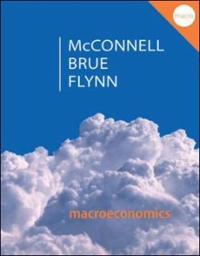Explain these questions
Consider a homogeneous good industry (such as an agricultural product) with just two firms and a total market demand Q = 400-P, so the inverse demand is P = 400 - Q. Suppose both firms have a constant marginal cost equal to $100 per unit of output and a fixed cost equal to $10,000. One simple way to depict rivalry in a duopoly (2 firms) is the Cournot model. This model is reasonable in agricultural markets where firms choose production (plantings) in advance and the market price is determined later after the crop is harvested. In the Cournot model, we imagine that the two firms simultaneously choose their production or quantity and that demand (market clearing) determines the price given each firms' quantity. (a) Suppose (hypothetically) that the second firm produces 0 units, and the first firm anticipates this, so the first firm is the only seller. How much will the first firm produce (in this case the first firm acts as a monopolist and sets output where MR = MC)? Hint: The first firm's inverse demand is P = 400-(Q1 +Q2), but since Q2 = 0 we can write this as P = 400-Q1 and so MR = 400 - 2Q1. Mathematically this problem is the same as a monopoly problem. What quantity will firm 1 choose? What price will it charge? What are the producer surplus and profit? (b) Now suppose instead that the second firm produces exactly 100 units, and that the first firm anticipates this. The total output is the first firm's output, Q1, plus 100, so substituting Q1 + 100 for QT in the inverse demand implies that P = 300 - Q1. That is if firm 1 produces Q1 it expects the price to be 300-Q1. This implies that MR = 300-Q2. How much will firm 1 produce (set MR = MC)? What price will clear the market given the total output Q1 + Q2? What are the producer surplus and profit? (c) Explain intuitively why neither firm wants to change their production if each is producing 100 (Q1 = Q2 = 100)? Note that your are explaining why Q1 = Q2 = 100 is a Cournot-Nash equilibrium). (d) Calculate the total producer surplus (both firms) and consumer surplus in parts (a) and (b). Why is consumer surplus higher with 2 firms than with one firm? (e) Intuitively, why is the deadweight loss smaller with two firms than with only one firm?9. Sawtooth Machinery is considering a 4-year project to manufacture a new line of chainsaws. The project requires an investment of $760,000 and will generate $380,000 per year in earnings before interest, taxes, and depreciation (EBITDA) for the next four years. The investment will be depreciated straight line to zero over four years. In year 4, the company expects to sell the project for $4 million. The tax rate is 35%, and cost of levered equity is 13%. Sawtooth will borrow 40% of the project value and 6% in debt outstanding each year is shown on the table below: (7 pts) 0 1 2 Debt 304000 228000 152000 76000 O outstanding Use M&M's Proposition II with taxes to calculate the cost of unlevered equity. Use the spreadsheet to show work. 10. What are the unlevered project cash flows in years 0 through 4? (10 pts) 1 1. What is the NPV of the project if it were all equity financed? Hint: discount the unlevered cash flows in part (b) using the cost of unlevered equity in part (a) of this problem. (7 pts) 12. What is the NPV of debt financing? Hint: calculate the cash flows each year as the negative of (principal repayment and after-tax interest payment on outstanding debt). (8 pts)QUESTION 11 Consider a market for a homogenous product with four active companies. Firms have a constan marginal cost of production of $10. The market demand is given by D(p) = 90 - p. Firms set prices in a repeated game with infinite horizon and a discount factor 6 e [0, 1]. (a) [12 marks] Construct a subgame perfect equilibrium with trigger strategies in which firms collude on the industry-profit maximising prices and punish deviation by reverting forever to the static Nas equilibrium. Under which condition does this equilibrium hold? (b) [12 marks] Suppose the market demand only arises every second period. In other periods demand is equal to zero. Construct a subgame perfect equilibrium with trigger strategies in which firms collude on the industry-profit maximising prices and punish deviation by reverting forever to the static Nash equilibrium. Under which condition does this equilibrium hold?You are required to demonstrate trading strategies and instruments that would be appropriate to exploit price efficiency/inefficiency during the process of acquisition. Your analysis should forecast possible trading profit going forward until the appropriate cut-off date. (40%) 1) Drawing on the insights from previous section, describe the type of trading strategies and risk management tools intended for the event and your design principle for using these tools based on the result of event analysis 2) Demonstrate, using relevant trading instruments for the type of strategy used, e.g. long- short strategy and calculate total return from such strategy. 3) Calculate relevant statistics to demonstrate understanding on volatility and correlation amongst the trading pairs. 4) Illustrate how to avoid adverse price movement as a result of (a) unexpected down side movement for the long position; (b) unexpected up side movement for the short position; and the characteristics of the type of instrument used to hedge risks. 5) In retrospect, how to use (3) in combination with (2) to maximise profit










